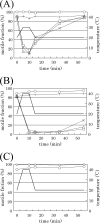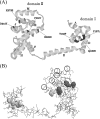Temperature-hypersensitive sites of the flagellar switch component FliG in Salmonella enterica serovar typhimurium
- PMID: 17496083
- PMCID: PMC1951853
- DOI: 10.1128/JB.00061-07
Temperature-hypersensitive sites of the flagellar switch component FliG in Salmonella enterica serovar typhimurium
Abstract
Three flagellar proteins, FliG, FliM, and FliN (FliGMN), are the components of the C ring of the flagellar motor. The genes encoding these proteins are multifunctional; they show three different phenotypes (Fla(-), Mot(-), and Che(-)), depending on the sites and types of mutations. Some of the Mot(-) mutants previously characterized are found to be motile. Reexamination of all Mot(-) mutants in fliGMN genes so far studied revealed that many of them are actually temperature sensitive (TS); that is, they are motile at 20 degrees C but nonmotile at 37 degrees C. There were two types of TS mutants: one caused a loss of function that was not reversed by a return to the permissive temperature (rigid TS), and the other caused a loss that was reversed (hyper-TS). The rigid TS mutants showed an all-or-none phenotype; that is, once a structure was formed, the structure and function were stable against temperature shifts. All of fliM and fliN and most of the fliG TS mutants belong to this group. On the other hand, the hyper-TS mutants (three of the fliG mutants) showed a temporal swimming/stop phenotype, responding to temporal temperature shifts when the structure was formed at a permissive temperature. Those hyper-TS mutation sites are localized in the C-terminal domain of the FliG molecules at sites that are different from the previously proposed functional sites. We discuss a role for this new region of FliG in the torque generation of the flagellar motor.
Figures




Similar articles
-
Charged residues of the rotor protein FliG essential for torque generation in the flagellar motor of Escherichia coli.J Mol Biol. 1997 Mar 7;266(4):733-44. doi: 10.1006/jmbi.1996.0836. J Mol Biol. 1997. PMID: 9102466
-
Torque generation in the flagellar motor of Escherichia coli: evidence of a direct role for FliG but not for FliM or FliN.J Bacteriol. 1996 Jan;178(1):223-31. doi: 10.1128/jb.178.1.223-231.1996. J Bacteriol. 1996. PMID: 8550421 Free PMC article.
-
Structure of the C-terminal domain of FliG, a component of the rotor in the bacterial flagellar motor.Nature. 1999 Jul 29;400(6743):472-5. doi: 10.1038/22794. Nature. 1999. PMID: 10440379
-
Structure and function of the bi-directional bacterial flagellar motor.Biomolecules. 2014 Feb 18;4(1):217-34. doi: 10.3390/biom4010217. Biomolecules. 2014. PMID: 24970213 Free PMC article. Review.
-
Constraints on models for the flagellar rotary motor.Philos Trans R Soc Lond B Biol Sci. 2000 Apr 29;355(1396):491-501. doi: 10.1098/rstb.2000.0590. Philos Trans R Soc Lond B Biol Sci. 2000. PMID: 10836502 Free PMC article. Review.
Cited by
-
Temperature dependences of torque generation and membrane voltage in the bacterial flagellar motor.Biophys J. 2013 Dec 17;105(12):2801-10. doi: 10.1016/j.bpj.2013.09.061. Biophys J. 2013. PMID: 24359752 Free PMC article.
-
Antibodies and immune effectors: shaping Gram-negative bacterial phenotypes.Trends Microbiol. 2010 Jun;18(6):234-9. doi: 10.1016/j.tim.2010.03.001. Epub 2010 Mar 30. Trends Microbiol. 2010. PMID: 20359893 Free PMC article.
-
Flagellar formation in C-ring-defective mutants by overproduction of FliI, the ATPase specific for flagellar type III secretion.J Bacteriol. 2009 Oct;191(19):6186-91. doi: 10.1128/JB.00601-09. Epub 2009 Jul 31. J Bacteriol. 2009. PMID: 19648242 Free PMC article.
-
Regulatory Role of a Hydrophobic Core in the FliG C-Terminal Domain in the Rotary Direction of a Flagellar Motor.Biomolecules. 2025 Feb 1;15(2):212. doi: 10.3390/biom15020212. Biomolecules. 2025. PMID: 40001515 Free PMC article.
-
Characterization of lateral flagella of Selenomonas ruminantium.Appl Environ Microbiol. 2011 Apr;77(8):2799-802. doi: 10.1128/AEM.00286-11. Epub 2011 Feb 18. Appl Environ Microbiol. 2011. PMID: 21335384 Free PMC article.
References
-
- Francis, N. R., G. E. Sosinsky, D. Thomas, and D. J. DeRosier. 1994. Isolation, characterization and structure of bacterial flagellar motors containing the switch complex. J. Mol. Biol. 235:1261-1270. - PubMed
MeSH terms
Substances
LinkOut - more resources
Full Text Sources

